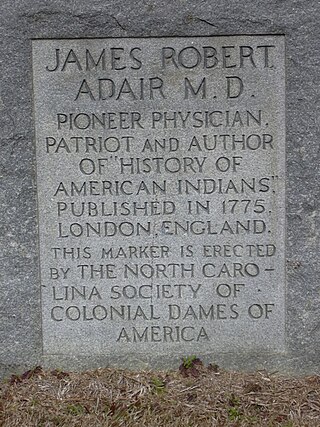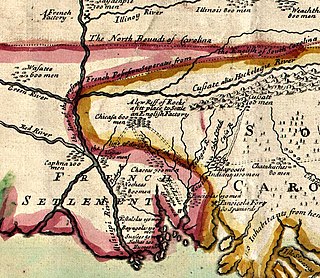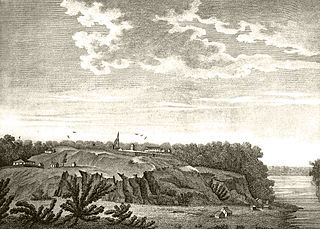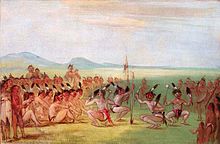
The Muscogee, also known as the Mvskoke, Muscogee Creek or just Creek, and the Muscogee Creek Confederacy, are a group of related Indigenous peoples of the Southeastern Woodlands in the United States. Their historical homelands are in what now comprises southern Tennessee, much of Alabama, western Georgia and parts of northern Florida.

The Chickasaw are an Indigenous people of the Southeastern Woodlands, United States. Their traditional territory was in northern Mississippi, northwestern and northern Alabama, western Tennessee and southwestern Kentucky. Their language is classified as a member of the Muskogean language family. In the present day, they are organized as the federally recognized Chickasaw Nation.

The Creek War, was a regional conflict between opposing Native American factions, European powers, and the United States during the early 19th century. The Creek War began as a conflict within the tribes of the Muscogee, but the United States quickly became involved. British traders and Spanish colonial officials in Florida supplied the Red Sticks with weapons and equipment due to their shared interest in preventing the expansion of the United States into regions under their control.

The Chickasaw Campaign of 1736, also known as the First Chickasaw War, consisted of two pitched battles by the French and allies against Chickasaw fortified villages in present-day Northeast Mississippi. Under the overall direction of the governor of Louisiana, Jean-Baptiste Le Moyne de Bienville, a force from Upper Louisiana attacked Ogoula Tchetoka on March 25, 1736. A second force from Lower Louisiana attacked Ackia on May 26, 1736. Both attacks were bloodily repulsed.

The Natchez are a Native American people who originally lived in the Natchez Bluffs area in the Lower Mississippi Valley, near the present-day city of Natchez, Mississippi, in the United States. They spoke a language with no known close relatives, although it may be very distantly related to the Muskogean languages of the Creek Confederacy. An early American geographer noted in his 1797 gazetteer that they were also known as the "Sun Set Indians".

The Anglo-Cherokee War, was also known from the Anglo-European perspective as the Cherokee War, the Cherokee Uprising, or the Cherokee Rebellion. The war was a conflict between British forces in North America and Cherokee bands during the French and Indian War.

Mushulatubbee was the chief of the Choctaw Okla Tannap, one of the three major Choctaw divisions during the early 19th century. When the Principal Chief Greenwood LeFlore stayed in Mississippi at the time of removal, Mushulatubbee was elected as principal chief, leading the tribe to Indian Territory.

James Adair (c.1709–1783) was a native of County Antrim, Ireland, who went to North America and became a trader with the Native Americans of the Southeastern Woodlands.

The Cherokee–American wars, also known as the Chickamauga Wars, were a series of raids, campaigns, ambushes, minor skirmishes, and several full-scale frontier battles in the Old Southwest from 1776 to 1794 between the Cherokee and American settlers on the frontier. Most of the events took place in the Upper South region. While the fighting stretched across the entire period, there were extended periods with little or no action.

The Chickasaw Wars were fought in the first half of the 18th century between the Chickasaw allied with the British against the French and their allies the Choctaws, Quapaw, and Illinois Confederation. The Province of Louisiana extended from Illinois to New Orleans, and the French fought to secure their communications along the Mississippi River. The Chickasaw, dwelling in northern Mississippi and western Tennessee, lay across the French path. Much to the eventual advantage of the British and the later United States, the Chickasaw successfully held their ground. The wars came to an end only with the French cession of New France to the British in 1763 according to terms of the Treaty of Paris.
William Clyde Thompson was a Texas Choctaw-Chickasaw leader of the Mount Tabor Indian Community in Texas and an officer of the Confederate States of America during the Civil War. After moving north to the Chickasaw Nation in 1889, he led an effort to gain enrollment of his family and other Texas Choctaws as Citizens by blood of the Choctaw Nation in Indian Territory. This was at the time of enrollment for the Final Roll of the Five Civilized Tribes, also known as the Dawes Rolls, which established citizenship in order for the nations to be broken up for white settlement and to allot communal tribal lands to individual Indians. The Choctaw Advisory Board opposed inclusion of the Texas Choctaw as well as the Jena Choctaws in Louisiana, as they had both lived primarily outside of the Choctaw Nation. Thompson's case eventually went to the United States Supreme Court to be decided where he and about 70 other Texas Choctaws who had relocated to Indian Territory ultimately had their status restored as Citizens by Blood in the Choctaw Nation.
The Yowani were a historical group of Choctaw people who lived in Texas. Yowani was also the name of a preremoval Choctaw village.
Martin Luther Thompson was a Texas Choctaw leader and rancher who along with his relatives, William Clyde Thompson (1839–1912), Robert E. Lee Thompson (1872–1959) and John Thurston Thompson (1864–1907), led several families of Choctaws from the Mount Tabor Indian Community in Rusk County, Texas to Pickens County, Chickasaw Nation, I.T.
The Cherokee have participated in over forty treaties in the past three hundred years.
The Cherokee people of the southeastern United States, and later Oklahoma and surrounding areas, have a long military history. Since European contact, Cherokee military activity has been documented in European records. Cherokee tribes and bands had a number of conflicts during the 18th century with Europeans, primarily British colonists from the Southern Colonies. The Eastern Band and Cherokees from the Indian Territory fought in the American Civil War, with bands allying with the Union or the Confederacy. Because many Cherokees allied with the Confederacy, the United States government required a new treaty with the nation after the war. Cherokees have also served in the United States military during the 20th and 21st centuries.

The Natchez revolt was an uprising by the Natchez Native American people against French colonists near present-day Natchez, Mississippi, on November 29, 1729. The Natchez and French had lived alongside each other in the Louisiana colony for more than a decade prior to the incident, mostly conducting peaceful trade and occasionally intermarrying. After a period of deteriorating relations and warring, Natchez leaders were provoked to revolt when the French colonial commandant, Sieur de Chépart, demanded land from a Natchez village for his own plantation near Fort Rosalie. The Natchez plotted their attack over several days and managed to conceal their plans from most of the French; colonists who overheard and warned Chépart of an attack were considered untruthful and were punished. In a coordinated attack on the fort and the homesteads, the Natchez killed almost all of the Frenchmen, while sparing most of the women and enslaved Africans. Approximately 230 colonists were killed overall, and the fort and homes were burned to the ground.

The Mount Tabor Indian Community is a cultural heritage group located in Rusk County, Texas. There was a historical Mount Tabor Indian Community dating from the 19th century. The current organization established a nonprofit organization in Texas in 2015.

The Choctaw Civil War was a period of economic and social unrest among the Choctaw people that degenerated into a civil war between 1747 and 1750. The war was fought between two different factions within the Choctaw over what the tribes's trade relations with British and French colonists should be. Hundreds of Choctaw died in the war and the pro-French faction retained their influence within the Choctaw nation.
The History of the Choctaws, or Chahtas, are a Native American people originally from the Southeast of what is currently known as the United States. They are known for their rapid post-colonial adoption of a written language, transitioning to yeoman farming methods, and having European-American and African-Americans lifestyles enforced in their society.
Piomingo was a Chickasaw chief and diplomat. President George Washington and Piomingo considered themselves to be friends. He was a signatory to the Chickasaw Treaty of Hopewell. Piomingo received a presidential peace medal from Washington for his loyalty to the US.















